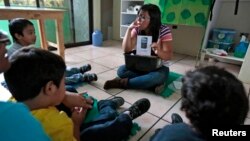Siblings with autism are more likely to be different from each another than similar, at the genetic level.
The largest genetics study ever conducted has uncovered DNA differences between autistic children and an autistic brother or sister. The finding points to the complexity of the neurodevelopmental disorder that is not easily tied to inheritance.
The findings of the study — looking at the whole genomes of 340 individuals from 85 families — surprised researchers, who expected that siblings with autism would have similar alterations of DNA.
But that is not what investigators, including Robert Ring, discovered when they peered at the DNA of autistic families using high-tech genetic sequencing technology.
"You might predict ahead of time that if you have autism affecting more than one child, you would see similarities in the genetic predisposition for that between the children," he said. We actually see something very different."
Ring, of the advocacy group Autism Speaks, says researchers found that in almost 70 percent of cases in which two siblings developed autism, lightning essentially struck twice. Each child inherited their own set of genetic mutations with little or no overlap in genes between them.
Only 31 percent of sibling pairs were shown to share the same autism-associated DNA changes.
The study by U.S., Canadian and Swedish researchers was published this week in the journal Nature Medicine.
Autism is marked by varying degrees of disassociation with the outside world, including impairment in verbal and non-verbal communication and social interaction, and repetitive behaviors starting at a young age.
The neurodevelopmental disorder occurs along a continuum, with some children more severely affected than others. Ring says each pattern of differences has its own clinical manifestations and behaviors.
"We frequently refer to these differences as the same differences you might see in snowflakes," said Ring. "Every snowflake is different when you take a really close look at it. And indeed, as you look from one child to another child, the same unique differences are present there."
Ring says the findings strongly suggest that there are influences beyond genetic inheritance that play a role in the development of autism and the form it takes.
"This study definitely shows that in a family where two siblings have autism and they are genetically very similar but still different, we are seeing very different mutations in most cases behind that autism," he said.
He said this type of work will continue to grow.
"Hopefully in the next few years will be able to have a much clearer idea of the different sub-types of autism that can be explained through the lens of genetics," he added.
Ring says a full assessment of each child's genome can inform educators and therapists about the best way to personalize treatment for kids with autism.




